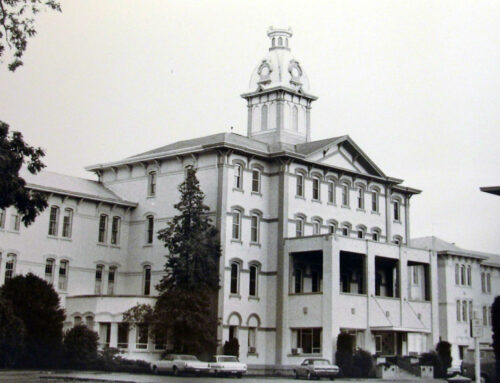This is the New York Times article announcing the death of Dr. Dean K. Brooks, former superintendent of the Oregon State Hospital and great friend of the OSH Museum. Original article: http://www.nytimes.com/2013/06/01/arts/dean-brooks-cuckoos-nest-doctor-dies-at-96.html?_r=0.
Dean Brooks, ‘Cuckoo’s Nest’ Doctor, Dies at 96
Dr. Dean Brooks, left, and Jack Nicholson in a scene from “One Flew Over the Cuckoo’s Nest.”
By MARGALIT FOX
Published: May 31, 2013
Dr. Dean Brooks, the superintendent of the Oregon psychiatric hospital where the Oscar-winning picture “One Flew Over the Cuckoo’s Nest” was shot — and who had a small, well-received on-screen role as the fictional hospital’s superintendent — died on Thursday at his home in Salem, Ore. He was 96.
His daughter Dennie Brooks confirmed the death.
The superintendent of Oregon State Hospital in Salem from 1955 to 1981, Dr. Brooks was known in his field as an innovator. His approach, unusual for its day, included letting patients wear their own clothes rather than hospital uniforms and taking them on therapeutic trips into the wilderness.
Dr. Brooks became known to a wide public in the mid-1970s, after he agreed to let the director Milos Forman film “Cuckoo’s Nest” on location at the hospital, a Victorian behemoth that opened in 1883.
In the movie, released in 1975 and based on Ken Kesey’s 1962 novel, Dr. Brooks portrayed Dr. Spivey, the well-meaning but weak-willed psychiatrist who directs the mental hospital in which the dystopian drama unfolds.
The film starred Jack Nicholson as the obstreperous patient R. P. McMurphy and Louise Fletcher as the tyrannical Nurse Ratched. It won five Academy Awards, including best picture, best director and acting awards for Mr. Nicholson and Ms. Fletcher.
Scouting locations, the producers, Saul Zaentz and Michael Douglas, were rebuffed by several West Coast hospitals before winning Dr. Brooks’s approval.
“They wanted to make a movie where real people had lived and died,” Dr. Brooks told National Public Radio last year. “I was quite ready to say, ‘Yes, let’s do that, and do that here.’ And we did.”
At Dr. Brooks’s behest, Mr. Forman and one of the screenwriters, Lawrence Hauben, lived in the hospital for weeks, interacting with patients and observing their daily routines.
As he came to know the sober, plain-spoken, silver-haired Dr. Brooks, a psychiatrist with no acting experience, Mr. Forman realized he had his Spivey.
But when Dr. Brooks read for the part, he later said, he found Spivey’s lines unbearably stilted. Mr. Forman agreed to let him and Mr. Nicholson ad-lib their scenes together — including a pivotal one in which Spivey conducts McMurphy’s intake interview, completed in just two takes.
Dr. Brooks helped shape the film in other ways. Because it graphically depicted several midcentury therapies — including electroshock treatment and lobotomy — that had fallen out of favor by the time it was shot, he insisted that it be set in the early 1960s instead of the ’70s.
He also insisted on a disclaimer to the effect that the film was not a true-to-life depiction of a modern psychiatric hospital.
Dr. Brooks was criticized by some colleagues for allowing the filmmakers in. But the benefits to the hospital’s patients, he said, were worth the intrusion: he secured jobs on the film, as extras and assistants to the crew, for 89 of them.
“One patient was so emboldened by the responsibility that he permanently lost his stutter,” The New York Times wrote in 2000.
Dean Kent Brooks was born in Colony, Kan., on July 22, 1916. (Because he was known on the set of “Cuckoo’s Nest” by his time-honored nickname, Deaner, the film erroneously credits him as Dean R. Brooks.)
He earned a bachelor’s degree from the University of Kansas, Lawrence, and an M.D. from the university’s Kansas City, Kan., campus. During World War II he served in the Navy as a medical officer in the Pacific.
Dr. Brooks’s wife, the former Ulista Jean Moser, died in 2006. Besides his daughter Dennie, he is survived by two other daughters, Ulista Jean Brooks and India Brooks Civey; a brother, Robert; five grandchildren; and two great-grandchildren.
Oregon State Hospital is still in operation. It now also houses the Oregon State Hospital Museum of Mental Health, which includes an installation on the making of “Cuckoo’s Nest.”
In an interview with The Statesman Journal of Salem in 2005, Dr. Brooks spoke of his initial reluctance to let the film be shot at the hospital.
“It was possible that my whole professional career would go up in flames,” he said. “The thing I worried about was that it would be taken as a documentary rather than as the allegory that it is.”






